« May 2011 | Main | September 2011 »
June 25, 2011
Diving the Revillagigedos (Socorro): Mantas!
Difficult to pronounce for Anglosaxon tongues, the Revillagigedos are a remote group of islands about 250 miles west of the Pacific coast of Mexico. Exclusively reached via liveaboard vessel from the port of Cabo San Lucas at the southern tip of Baja California, Mexico, the islands are not a group as much as four random peaks of rock poking through the surface of nowhere more or less in the same general vicinity.
After a 24 hour passage at sea (that can be rough), San Benedicto comes into view, a 4-square mile island that is about as volcanic as it gets, with the last massive eruption just over 50 years ago. From there it’s either a 35 mile run to Socorro—with a land area of about 50 square miles the largest island of the group and the one that gives the Revillagigedos its more popular name, Socorro Islands—or an 85 mile ride to Roca Partida, which is not really an island at all, but just a small rock. The distance between Socorro and Roca Partida is about 70 miles, concluding the triangle. There is a fourth island, Clarion, another hundred miles beyond, and not usually on the itinerary of anyone. With the exception of the Mexican Navy that keeps a small garrison on Socorro and an even smaller outpost on Clarion, the islands are uninhabited.
Among divers, Socorro is famous as a remote destination where one can see sharks and, more importantly, giant manta rays. These islands are not for those who seek lush shallow reefs teeming with colorful tropical fish (though color certainly isn’t absent). The volcanic underwater scenery around the Socorro islands is starker and darker, the water is colder, the currents stronger, just what the big fish like. This is what we signed up for when we booked our trip on the Solmar V, a 112-foot live-aboard vessel based in Cabo San Lucas.
I still didn’t know what to expect. From what I had heard, read and Googled, everyone agrees on the sharks and manta rays and the great food on the Solmar V. Everyone agrees that it is a great experience, but other than that, opinions range from wonderful and pleasant to intimidating and only for the advanced.
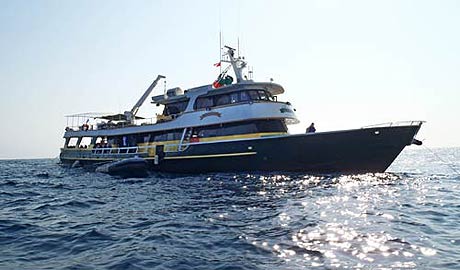
The green and white Solmar V made a grand first impression, as did the captain who greeted us in a white uniform. Inside, the Solmar is all wood and brass and the look and feel of the main deck is like that of an elegant pub. It reminded me of a more compact version of what you see in old luxurious river paddle boats such as the Delta King or Queen. Seating is in booths or small club-like bar tables for two. Lighting in the ceiling looks like brass portholes and some are colorful stained glass.
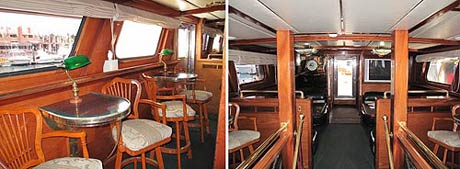
We had been warned both by Solmar literature and trip reviews that the rooms were small, and that is certainly true. Compared to them, the cabins we had on the Caribbean Explorer II was very large and the one we had had on the Turks and Caicos Explorer was huge. On the Solmar, our #304 had stacked beds with the bottom not wide enough for the two of us, and the top requiring a good deal of agility and a lack of any claustrophobic tendencies as headroom is virtually non-existent. There is one very small cabinet, a tiny sink, a few cubbies, a few outlets, and nothing more. These rooms are essentially bunks, without any chairs or desk space. Bathroom and shower are combined into one, so you can sit on the toilet while taking a shower.
The Solmar V left port around 4pm to some spectacular landscape with massive rocks, an arch, cliffs, spires, with waves pounding at them. Right outside the port we also passed a humongous cruise ship, the “Carnival Splendor,†that dwarfed to Solmar and seemed entirely out of place and proportion. It reminded me of the huge difference between hose floating cities and diving off a live-aboard. Then we were on the open sea and things instantly got pretty rocky, though it was a sunny day. The Solmar pitches and rolls quite a bit, and spray washes over the bow so that it is not advisable to hang outside while underway.
Then it was time for a briefing. The highlight here is the Pacific Giant Manta. There would be five full days of diving, plus one checkout dive the first day. Maximum depth at any site is 130 feet. Do not touch or chase anything. Any dives from the Panga are max 50 minutes, any dives from the Solmar are 60 minutes max. Nitrox mix is 32% for Socorro and San Benedicto, 28% for Roca Partida so that divers can to down to 130 feet. The only animals that like chasing are dolphins, and they are also the only exception to no-touch rule, but only when they invite us. With hammerheads and other sharks, stay as still as you can so they don't scatter. If you stay still they may come closer. If we were to encounter whale sharks, be careful and get out of the way as their touch can be very strong. They often make passes and then come back.
After an almost 24 hour ride, the island of San Benedicto came into view, and what a view it is. Stark, yet varied, with massive rock formations, visible layers, and probably a geologist's dream. The volcano part is all light gray and textured in a very unique way. What on Google Earth looked like a forested part of the island that had escaped the volcanic eruption is, in fact, just black lava. As we got closer to the island, pods of dolphins followed us, jumping out of the water and racing around the bow of the Solmar. The weather, unfortunately, was overcast and breezy.
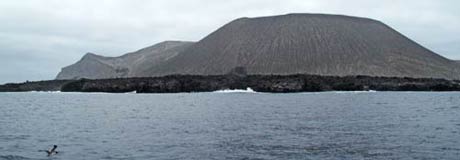
The water wasn't nearly as warm as expected, perhaps in the high 60s. We worked our way down the anchor line, then followed the divemaster around for our check-out at the El Fondeadero dive site, which is three coral blocks sitting on sloping sand.
Dive site the next morning was El Boiler, a terraced seamount with three levels, the highest of which goes to 20 feet within the surface. There was very strong current and we had to hang on to the anchor line for dear life. Once down the viz was quite decent, though still no more than perhaps 75 feet. Our group of seven began a clockwise pass around the structure, at times against strong current and surge. Two or three dolphin swooped in, then quickly disappeared. The water was warmer than on the first dive, with warm and cold currents. As for depth, we were mostly in the 80s. We didn't see anything extraordinary, and definitely no mantas. Getting back on the boat was a bit tricky due to the waves.
The third dive was a hit. We had moved to another San Benedicto location, called Cape Fear. The current was fierce on the way down the anchor line, and at the bottom as well. First I thought we'd have to go right back up. But then we clawed ourselves over some cliffs and coral, and it was fairly clear that we would not end up at the anchor line for the way back. The pangas would pick us up. The reef was very nice and visibility had improved to very good.
Then we saw the first giant manta. It lazily flew by, then came back for a second pass. We ascended to get a better look and perhaps see more of it, but the creature had vanished. We settled for the safety stop when another manta appeared. And then another. They hung around, glided, flew, turned, twirled, sometimes almost at the surface. Everyone was in awe and so we watched the spectacle for another 20 minutes until we ran low on air.
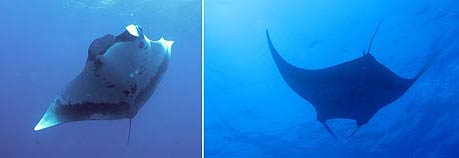
With an ear ache, I skipped the first dive the following morning by what was now Socorro, dive site Cabo Pearce. Socorro is a much larger island than San Benedicto, and there was a spectacular sunrise. I did snorkel, though, in very clear water, watching the divers’ bubbles. Wearing just long swim pants and a long-sleaved top, I didn’t get cold though I was in the water for almost an hour.
I did the second dive at Cabo Pearce though there was current. Down the anchor line we went, then along some nice reefs. The water was much warmer here, mid 70s. Towards the end of the dive, giant mantas showed up, and it was a near perfect situation, with the mantas coasting around us in shallow, brightly lit water. They came very close, almost touching us. There is an awesomeness factor here that you cannot find anywhere else. According to one of the dive masters, Socorro Cabo Pearce has been the best manta place as of late.
Back on the boat, we motored over to the Mexican base where a boat with six or eight Mexican Navy personnel boarded us, machine guns and all. The crew said they simply came to check us in. They were served soft drinks, checked for half an hour or so, then left. We’re told the personnel there stays for a month, then serves somewhere on the mainland before they return.
After dinner the Solmar V began the eight or nine hour trip to Roca Partida where all diving will be off the pangas. We'll be using Nitrox 28 there because the dives will be as deep as 130 feet. The trip was very rocky and it took us a long time to get to sleep with the Solmar heaving and rolling. In those conditions, it often feels like you are are awake when, in fact, you are not. At some point the boat dropped anchor and we were there. I slept through it.
When my alarm went off at 6:30am, the sun had just come up over the endless horizon. I looked for Roca Partida, and there it was, smaller than I expected, and certainly not a hundred meters high as some sources claimed. More like 15 meters or 50 feet. The two peaks are joined and the upper three quarters are all white from the guano. The lowest part shows how far up the waves wash.
The sea was fairly calm, but with large slow swells. All diving at Roca Partida is off the pangas. It is quite a bit of logistics to get 11 BCs with tanks and weights and fins, as well as 11 divers in each of the pangas. Our panga driver, Geronimo, was a real pro, friendly, funny and competent.
Being at Roca Partida gives you this sense of really and truly being away from civilization, and it is. Some 300 plus miles out in the ocean, just a small rock, and far away from any shipping lane.
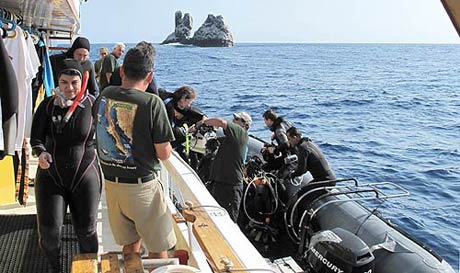
We got in the panga after listening to the dive briefing, headed towards the rocks, and then, on the count of three, all plunged into the water backward. It was fairly clear and so we followed the dive master (Erick) towards the rock which looks very much larger and more impressive underwater than above. It is just sheer cliff plunging down to a bottom at 220 feet or so. First we encountered a lot of current, then a terrific place with tons of fish including sharks above us and below us and around us.
I would have loved to hang around there, but our dive master, using long freediver fins, was moving on and we breathed hard to keep up with him. On the other side of the rock was clear water (though nowhere near as clear as I had expected), and there were those ledges where white tip sharks laid. In one they rested together with a big moray, all in one place. Again I wanted to stay and take it all in, but the DM urged us on and we came to another calm place with sharks of all kinds. Unfortunately we didn’t stay there either and the group was led into blue water where there were no more sharks, albeit a lot of small fish. So there we then hung for another 15 minutes, away from Roca Partida, away from all the sharks. None too happy over all the rush, I reentered the panga after a 44 minute dive, with a max depth of 95 feet. Two more dives hinted at the potential of this site, but this time the conditions just weren't very good.
We had a smooth ride back to Socorro and I slept so soundly that I didn't even hear the anchor. Awoke to a nice day at Socorro where we anchored at Cabo Pearce. The good news here was that the water temperature was an acceptable 75 degrees and that the current was fairly mild. Visibility however was mixed. We went down the anchor line to the 40 foot top of the reef, then Carol and I decided, somewhat wary of long blue water power swims, to go by ourselves and explore the reef. It is rocky and volcanic mostly, with lots of trumpet fish, angels, and a good number of urchins and sea cucumber like creatures. I dove off a spectacular wall to score another 100 foot dive, is time on Nitrox 32 again.
All divers used nitrox on this trip, meaning I almost never had to worry about bottom time. The average depth on Solmar dives is fairly deep, and I can only imagine the limitations of air diving. It just makes no sense to miss parts of good dives having to go shallow (which here often means into blue water with nothing in sight).
I skipped the final panga ride at Socorro, which was at Roca O'Neil, a small island/rock off the northern I think tip of Socorro. Apparently they had tank and o-ring problems that delayed things, and there wasn't much to see. I spent the time on the top deck, enjoying the vista and reading a book.
This morning we awoke to the breathtaking vista of San Benedicto, with the sun lazily coming up and burning through the haze. The dive site was El Canon, a horseshoe canon with a number of reefs. The idea here is to hang on to a reef or rock at the edge of the deep water and then have the animals swim by you.
The boobie birds here are very tame. You can actually make them sit on your hand or arm. They have a hard time landing on the boat when it is moving and seem to appreciate a bit of help. They had flat, webbed feet and sort of grab hold of your hand, then just sit there and hang, not even pooping much.
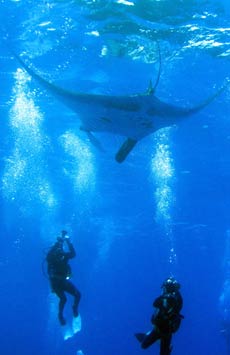
With El Canon not offering much, the captain moved up to Cabo Fear. And that turned out to be the trip's best dives. The water was fairly warm, there was little current, and the visibility was quite good. As soon as we'd descended the anchor line the Mantas arrived, mesmerizing everyone with their majesty and effortless gliding. We followed the mantas who circled above us, and soon found ourselves in 100 feet of water! They tend to lead you, or rather, you tend to follow. Seeing a manta appear and then glide by is certainly unique. At times there were three or four gliding by, circling us, looping together, and very obviously eying us. Common wisdom has it that e mantas like the tickle of divers' air bubbles, but I did not find that to be true. In fact, they seemed to avoid the bubbles, carefully gliding around them.
Then it was time for the last dive on this trip, again at Cabo Fear. We settled in a nice, leisurely pace. The Mantas were the again from the start, and so we had a most enjoyable 45 minutes with them. Certainly a great conclusion.
The final morning was a bit bittersweet. It was in some way good to be in port again, with firm land just a few feet away, but no one wanted the trip to end. From here, we'd soon disperse into the seven countries we'd come from to spend these unforgettable nine days (Canada, US, Portugal, Poland, England, France and the Philippines).
Posted by conradb212 at 8:07 PM
June 17, 2011
Milestones
I finally had my 200th dive, and just like #100, it was at a memorable location. Much went through my head as I plunged into the ocean backwards off a panga at Roca Partida, as remote and wild a dive location as one can find. More remote even than the tiny island of French Key off the coast of Providenciales for my 100th.
200 dives in five years doesn't sound like much, just 40 dives a year. But considering that a local dive outing adds just a dive or two, and even a dedicated dive vacation usually no more than 10 to 20. The most I ever did was 28 on a nine day trip to Honduras, but a week in Northern Florida yielded just seven.
Where does the fascination with numbers come from? Most divers seem to have it, and "How many dives do you have" is asked among divers as often as by dive operators. Even PADI's official dive log has inserts that suggest becoming a rescue diver after 25 dives, and considering a professional career in diving when you hit 50. Scuba boards and forums classify posters by how many dives they have.
How many dives is a lot? That depends. Carol amassed over 2,500 dives in her 12 year career as an active scuba instructor. Dive masters in tourist destinations can easily reach thousands as well. But how about regular folks who just go on a dive vacation every other year or so and also want to do some sight seeing and not just diving? That way, it might take decades to reach a couple of hundred.
Me, have I truly become a diver with my 200 dives? By most standards, yes. I have been diving in a very wide variety of settings, from springs to rivers to caverns to lakes and the ocean. From cold water to warm, from shores and from boats, and in good conditions and bad. I have a couple dozen dives a hundred feet or deeper, explored wrecks, and taken thousands of photographs and many hours of video. I've swum with sharks and giant mantas, and played with dolphins and sea lions. I have some extra certification cards. I know my gear inside out.
But am I now a truly experienced diver? No, I am not. I learn something new on almost every dive. And while I've been fortunate enough to dive in many different settings, compared to tech and extreme divers, my diving has been almost routine. No decompression diving, no dives deeper than the recommended 130 foot recreational diving limit, no caves, no rebreathers, nothing extreme.
After 200 dives, sometimes I feel quite accomplished, certain that I know what I am doing. Other times, especially when I get pummeled around by current or surge, I feel like a total neophyte.
What I do know is that diving has opened a new world to me, a world of adventure and places few ever get to see, and my life is definitely the richer for it.
Posted by conradb212 at 4:09 PM








